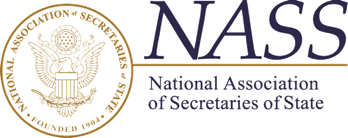Adopted July 13th, 2011; Reaffirmed July 17th, 2016; August 16th, 2021
The Notary Public Administration (NPA) Section of NASS is a collection of state government representatives, most of whom work for the Secretary of State, who are experts in the field of notary law and practices. In an effort to further goals of the NPA Resolution to achieve uniformity, to the greatest extent possible, of the characteristics of an apostille, the members of the National Association of Secretaries of State endorse their resolution.
Resolution of the Notary Public Administrators A Section of the National Association of Secretaries of State
July 20, 2010 Resolution
Recognizing that under the Hague Apostille Convention of 1961 each Competent Authority retains the discretion to issue Apostilles in a form consistent with the basic requirements of the Convention;
And further recognizing that this affords the possibility of a variety of forms;
And further recognizing that the variety of forms issued by US state Competent Authorities has led to confusion among and rejections by intended recipients of US state-issued Apostilles;
And further recognizing that a higher degree of uniformity among US state-issued Apostilles would alleviate confusion and minimize rejections;
The Notary Public Administrators, in order to implement a series of best practices with the goal of achieving uniformity to the greatest extent possible, and in conformity with the Conclusions & Recommendations adopted in 2003 and 2009 by the Special Commission on the practical operation of the Hague Apostille Convention;
Resolve to adopt the following best practices:
• The Apostille shall conform to the model certificate annexed to the Hague Apostille Convention in the form of a bordered square with sides at least 9 centimeters long on an allonge that is 8.5 x 11 inches.
• The type of paper to be used for the certificate is at the discretion of the Competent Authorities. • When affixing an Apostille, Competent Authorities should use the following procedures:
• Offset the allonge
• Affix the allonge to the front of the page that contains the signature and seal that is certified
• Apply a stamp that overlaps the allonge and the underlying public document
• Where feasible, the allonge should be affixed on the left side of the public document; otherwise the allonge may be attached as appropriate. The readability of the Apostille and the public document should be the primary consideration in making this determination.
• Competent Authorities shall use tamper-evident methods of affixation. The Notary Public Administrators recommend the use of grommets as a uniform standard.
• The following language should be used outside the bordered square: “This Apostille only certifies the authenticity of the signature and the capacity of the person who has signed the public document, and, where appropriate, the identity of the seal or stamp which the public document bears. This Apostille does not certify the content of the document for which it was issued. This Apostille is not valid for use anywhere within the United States of America, its territories or possessions. [To verify the issuance of this Apostille: [www.e-Register of issuing state]]”
And the Notary Public Administrators further resolve to encourage the active consideration of issuing electronic Apostilles (e-Apostilles) and operating electronic registers (e-Registers) of Apostilles as suggested by the electronicApostille Pilot Program (e-APP).
EXPIRES: Summer 2026

